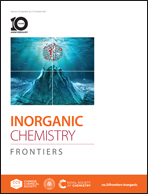Humidity and ultraviolet modulate color turned LnNa-based metal–organic frameworks as Bi-decryption anti-counterfeit materials†
Abstract
Dynamic multi-decryption with luminescent anti-counterfeit materials still presents a challenge in information storage and security. In this work, Gd3+ is introduced into the structure of lanthanide-based metal–organic frameworks (LnMOFs) ([LnNa(HL2)2(H3L2)0.5]·EtOH, H3L2 = 5-hydroxy-isophthalic acid, abbreviated as LnHIP) to adjust the Ln–Ln distances. The emission intensity of Tb3+ and Eu3+ reached a maximum with the dilution rate of Gd3+ fixed at 50%. The temperature-dependent luminescent properties reveal thermal stability even at an ultra-low temperature. The developed samples present water sensitive properties, thus the luminescence could be quenched by water atomization. Furthermore, by combining inkjet printing and the water quenching effect, the encrypted information could be decrypted by ultraviolet irradiation and water atomization successively. These results demonstrate the promising applications of LnMOFs in dynamic information decryption with Gd3+ doping to save cost and enhance luminescence intensity.



 Please wait while we load your content...
Please wait while we load your content...